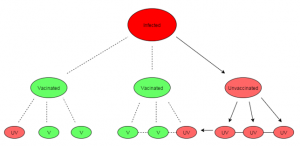Disease Networks and Herd Immunity
The use of networks to study the spread of sickness and disease is one of humanity’s greatest health tools. Before the advent of modern vaccinations, measles contagion could cause large networks of disease. Every infected person could spread the disease to multiple others, quickly leading to many sick and dying people. Thankfully, after the measles vaccine was created in 1963 the number of reported cases dropped to an extreme low, despite not every person receiving treatment.
As described in McGinty’s article, “When large segments of a population are immunized against measles, it reduces the risk of exposure for everyone in the community, including families who refuse vaccines. The concept is called herd immunity.” As shown in the graph below, those who are unvaccinated (such as the pink oval on the bottom left) can be protected from contagion as long as an infected person (shown in red) isn’t connected to them by an edge or through another unvaccinated person. In this way, by vaccinating the majority of people it becomes increasingly unlikely that large sub-networks of vulnerable people exist. This herd immunity effectively reduces the chance that an infected person will be able to spread the disease.
Unfortunately, if there are a large number of unvaccinated people it is possible for the infection to spread from node to node as shown by the arrows on the right of the graph. Recently, this is becoming an issue as more and more people forgo measles vaccination for religious or other reasons. As stated in McGinty’s article, “a vaccination rate of 92 to 94% for measles” is what is needed to maintain herd immunity and prevent long chains of infection. However, in “seven states and Washington, D.C., fewer than 90% of kindergartners were vaccinated…” Due to this, sub-networks of vulnerable people become more prevalent and decrease the effectiveness of herd immunity. As these sub-networks gain larger amounts of unvaccinated nodes it becomes likelier that one will eventually come in contact with an infected person causing an outbreak. In order to maintain herd immunity and sever potential shared edges between those who are infected and those who are vulnerable or unvaccinated, it is paramount that children continue to be immunized.
Source:
http://www.wsj.com/articles/how-anti-vaccination-trends-vex-herd-immunity-1423241871

